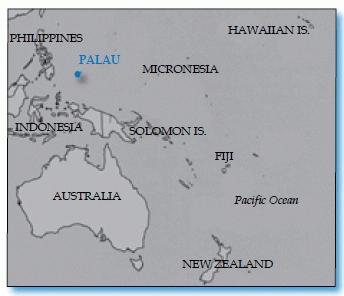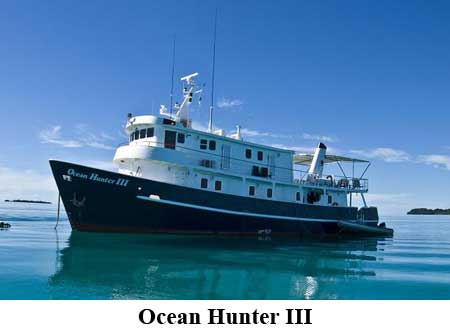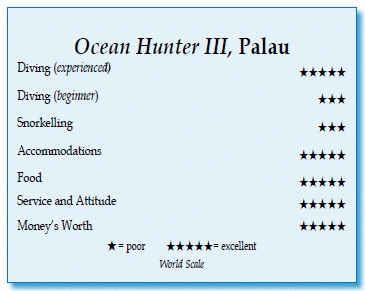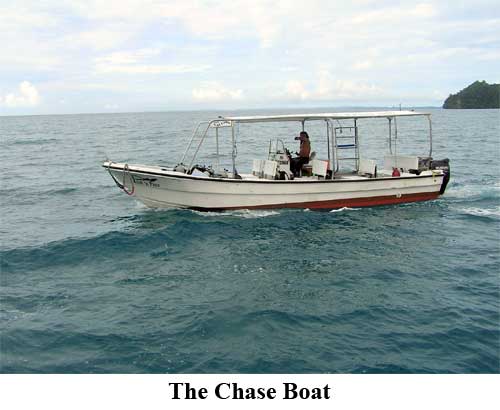Ocean Hunter III, Palau, MicronesiaContents of this Issue: MV Fling, Flower Gardens, Texas Ocean Hunter III, Palau, Micronesia “Both Divers Resisted the Natural Instincts of Self-Preservation” A “Too Exclusive” Island in Indonesia Hawaii Snorkeler Dies in Rough Water Readers’ Letters: Bends, Photographers and Scaring Sharks Editorial Office: Ben Davison Publisher and Editor Undercurrent 3020 Bridgeway, Suite 102 Sausalito, CA 94965 a rival to Raja Ampat for marine wonders from the September, 2014 issue of Undercurrent
Dear Fellow Diver: If you've never used a reef hook, you will quickly learn how to in the sixknot current in Palau's Ulong Channel. As I finned down the anchor line, I found the current manageable, but once over the wall, I could only relax and go with it until I was able to snag the reef with my hook to steady myself and watch the action. About a dozen seven-foot-long white-tip and gray reef sharks circled, several making close passes, even within touching distance. Schools of tropical fish teased them, and a couple of fish suffered the consequences. When it was time to go, I deflated my BCD, unhooked and careened into rocks before I could balance myself and join the six other divers for the wild ride through the channel. I bounced with down drafts and skirted mini sand tornadoes, soon losing sight of the divers ahead. Then at the end of the channel, the current normalized, the blizzard of sand settled and we quickly regrouped. Surfacing, I spat out my regulator and whooped. "Let's do it again!"
When it comes to diving, Palau's Blue Corner gets the most hype. The day after I arrived, I hooked in at 75 feet, near the corner that cascades into the deep, to be entertained by white-tip and gray reef sharks, schools of midsized colorful tropicals and five-foot Napoleon wrasse. The slow-moving, bluish- green wrasses, each weighing approximately 300 pounds, cut an impressive picture. Two seemed eager to be stroked by divers, and made passes within six inches, leaning toward divers' hands. Six-foot-long dogtooth and yellow-fin tuna, large mackerel, and schools of bigeye trevally added to the big fish census. While I saw fewer sharks than in 2008, Navot Bornovski, who owns both Fish 'n Fins' and the Ocean Hunter liveaboards, told me by email that shark mating season runs from February to April, during which many nonresident sharks join the party. During my July trip, apparently only local sharks were parading. Novot's wife, Tova, has been conducting research for more than a decade with the Micronesian Shark Foundation, which they founded, and she has not found a significant decline in overall shark population. Since making Palau their home in 1993, the Bornovskis have been leaders in conservation efforts, including establishing a protected shark nursery in the Rock Islands. One of my favorite sightings was at nearby Clarence's -- an 11-foot zebra shark, with its telltale leopard spots and unusually long tail.
Dives are conducted from the comfortable 35-foot chase boat, which has cushioned seats atop waterproof bins for dive extras. Its two 140hp outboards swiftly took us to dive sites. Gear stayed onboard, only the tanks were changed. Epi, the driver, operated the nitrox analyzer, checking as I watched. Always with a ready smile and helping hand, Epi handled the boat like it was his second skin. Nitrox was usually 31-32 percent, with tanks topped at 3000 to 3200 psi. After Epi or dive guide Jed helped me with gear, I'd backroll off, grouping with others at the anchor or line before descending. While I like to take my time viewing fish and critter behavior, the other divers seemed to prefer a faster pace. After several dives, Jed eventually became comfortable with my lagging or disappearing into a swim-through. A couple of times, Epi, an excellent spotter, dived with me. I returned to the boat at my own pace, sometimes 15 minutes after the prescribed one-hour dive times. On the surface, the crew hauled up my tank and BCD, and I climbed the ladder into this stable boat. (These days, I don't go on boats without easy boarding ladders. In the Caribbean, my shoulder muscles were torn when I was pulled into a boat by my arm, necessitating three months of physical therapy.) Wherever the mother boat moored, the surface was usually a gleaming mirror, but once when we motored through a channel for 10 minutes to our next dive sites, choppy waters ruled. Only two dives were above 60 feet; the remainder ranged from 60 to 110 feet. The visibility on most dives was over 100 feet. We dived German Channel twice, seeing two mantas on one of the dives. I haven't had much luck with manta viewing here. Big Drop Off is a vertical wall, heavily encrusted with plentiful gorgonians, including sea whips and sea fans. A huge iron ball and a thick heavy chain remain from when Americans used them in World War II to block the channel to keep Japanese from reinforcing their positions. In one crevice, I spotted a unique marbled shrimp, and later I saw sequestered nudibranchs, and a gigantic moray eel hiding in a hole, while adult and juvenile Oriental sweetlips abounded.
Each morning, fresh sweet rolls and juice got me out of bed for the 7 a.m. dives, then came a breakfast of eggs, sausage, bacon, toast, pancakes and fruit. Thus it went . . . dives at 10 a.m., 2 p.m., 4:30 p.m. (a dusk dive) and the night dive at 7 p.m. The buffet meals were interspersed with cakes, brownies and fruit smoothies. Dinner was scheduled for 8:30 p.m., but Arlee was most agreeable to serving me early one night, and another time making me a sandwich before the night dive to tide me over. He and his assistant prepared Middle Eastern, Palauan, Italian, Asian, American and French meals, and more simple fare, like fried fish with ginger sauce, just-caught sashimi, sushi, green salad and fresh fruit. Soups, such as tomato or potato-chicken, would kick off a meal. One day, I was happy to devour a hamburger and fries for lunch. Desserts weren't as memorable, but the ice cream always helped. One awesome moment: At Blue Holes, I dived down a vertical tunnel that opened into a cave at 80 feet. Orange stony cup coral was highlighted by dancing rays of light from tunnels. Blue Holes is also the entry point for the Temple of Doom, well-marked with skull-and-crossbones. It's a huge cavern, at least 300 feet wide, with just one entry, but only for those divers who are cave-certified, which I am not. At Virgin Hole, I made a thrilling descent through a large hole into a cave with a floor at 108 feet. Outside the cave, I finned though canyons and swim-throughs, spotting a stonefish on the underside of a ledge, the adult as well as the illusive juvenile barramundi, and several white-tip sharks, but the best part was the unique topography.
Having been to Palau before, I know that Peleliu's sites, the most distant from Koror, are the highlights. To my disappointment, however, Captain Ken decided not to steam there, noting that it was "swept clean" of corals in 2012 by Super Typhoon Bopha. Moreover, the currents were running very strong, a concern for all but very experienced divers. Aboard our floating home, it was interesting how the ambience changed as new divers came aboard. For the first few days, there were but four divers: a 30-something California couple, a Fish'n Fins dive instructor on a quasi-holiday, and me. We were experienced divers, and swapped great stories at meals. Then, three more people arrived: a graduate student from Switzerland (who fit right in), and a 50-something fellow with his 20-something lady friend. They shrugged at our dive schedule, she said little, and her companion told her to stay in her room when not diving (which she obeyed upon occasion). This unseemly fellow had requested a private guide. Because the boat was short one dive guide, who was on vacation, Captain Ken, also an instructor with 10,000 logged dives in Palau, pitched in. One morning, the controlling fellow complained that the nitrox label on his tank wasn't new and was difficult to read. Ken replied sarcastically, "Maybe your eyes aren't so good in the morning." The jerk blew up, belligerently yelling that his eyes were fine. It was a 10-minute harangue, and while the captain tried to appease, it was not well accepted. The next day, Ken developed a painful ear problem (probably from the yelling), so Captain Troy of Ocean Hunter I came aboard to become their dive guide, and kept the twosome away from us.
Palau Lagoon was a hot spot during WWII, and one can dive several dozen wrecks of ships, Zeros and seaplanes in its waters. My favorite was Iro, a 470- foot-long Japanese fleet oiler, resting at 120 feet, with the deck at 85 feet. I swam through the large torpedo hole, framed by black coral. A school of jacks swirled like a tornado. Many swim-throughs beckoned, but this brought Jed's disapproval. White daisy and bubble corals on the deck provided a striking visual contrast to the mussel encrustation. On the way back to the vessel, Epi drove us around an island, still with rusting Japanese guns protruding, into a small cove to see a dozen banded sea snakes on the rocks,their egg-laying place. High on Palau's must-do list is snorkeling in Jellyfish Lake, the landlocked saltwater lake with thousands of non-stinging jellyfish. Having done it already, I was hoping instead for a solo dive in the calm waters where the mother boat was anchored. However, Captain Ken said no solo diving, and a guide was not available. Saies Tunnel, near Ulong Channel, was a spectacular dive. Entering from the wall at 90 feet, I noticed the ceiling was covered with colorful corals, rose stylasters and hydroids. The bottom is at 130 feet. I exited past sea fans and soft corals, a couple of cruising sharks and swarms of colorful anthias. Ascending along the wall, the water exploded with boxfish, unicornfish, flatworms, nudibranch, gobies and blennies. A dusk dive found us at Saies Corner, where the wall was packed with soft and hard corals, and alive with tiny critters, fire dartfish, octopus, moray eels, four-foot-long bumphead parrotfish and courting groupers. In mild current, I hooked in for 20 minutes to watch gray reef sharks cruise by among a lineup of bannerfish, pyramid butterflyfish and yellowtail barracuda. The boat remained outside the lagoon of Mandarin Fish Lake, which was a total change of pace. I backrolled into just three feet of water, explored the edges of the encroaching mangroves, and wallowed in the water until I could descend. It was dusk and visibility was poor, but I finally located the two large coral heads in 17 feet of water that the Mandarinfish call home, and where they entertain with their spiraling-up-and-down mating ritual. With the trip over, and nitrogen depletion on my mind, I stayed in Palau another 40 hours before boarding my flight home. I opted for Ngellil Nature Island Resort, a 25-minute ride by small boat to an uninhabited resort island, with eight traditionally designed guesthouses and reception area manned by three Filipinos. The jungle encroached on three sides, the ocean on the other. I was the only guest. Quiet reigned except for birdcalls. A perfect place to do nothing, unless one decides, as I did, to kayak nearby caves, snorkel, and trek up the jungled hillside to an abandoned Palauan stone quarry. Even the remnants of a typhoon, lashing the island overnight with strong winds and deluge of rain, didn't disturb my tranquil state. Since my plane did not leave until 1:45 a.m., I relaxed on Koror in one of the two rooms in Ocean View, owned by the island resort, and reflected on my trip. Every dive in Palau was outstanding in some way; not one was so-so. In my well-traveled mind, only Raja Ampat competes for my top choice of a superb variety of diving. -- J.D.
|

I want to get all the stories! Tell me how I can become an Undercurrent Online Member and get online access to all the articles of Undercurrent as well as thousands of first hand reports on dive operations world-wide
| Home | Online Members Area | My Account |
Login
|
Join
|
| Travel Index |
Dive Resort & Liveaboard Reviews
|
Featured Reports
|
Recent
Issues
|
Back Issues
|
|
Dive Gear
Index
|
Health/Safety Index
|
Environment & Misc.
Index
|
Seasonal Planner
|
Blogs
|
Free Articles
|
Book Picks
|
News
|
|
Special Offers
|
RSS
|
FAQ
|
About Us
|
Contact Us
|
Links
|
3020 Bridgeway, Ste 102, Sausalito, Ca 94965
All rights reserved.

 A few days before, I worried I
might not be on this trip at all.
Because of a flight departure delay,
I missed my connection in Honolulu,
thereby getting to Koror a day late,
nine hours after the noon departure
time. However, a rep from the Palau
dive shop Fish 'n Fins met me at the
airport, whisked me to the office to
fill out forms, and then took me by
chase boat five minutes out to the
Ocean Hunter III, which had remained
close in. After being greeted by
Captain Kenneth Jolly, Chef Arlee sat
me down for a full dinner, including
fresh tuna sashimi. I then retired to
my air-conditioned deluxe cabin, with a
firm king bed and an upper bunk, ample
storage space, a desk, chair, private
head and fluffy white robes (some divers
wore them to breakfast the next
day). I was ready to undertake my second voyage on the Ocean Hunter since 2008,
again with the same captain and chef.
A few days before, I worried I
might not be on this trip at all.
Because of a flight departure delay,
I missed my connection in Honolulu,
thereby getting to Koror a day late,
nine hours after the noon departure
time. However, a rep from the Palau
dive shop Fish 'n Fins met me at the
airport, whisked me to the office to
fill out forms, and then took me by
chase boat five minutes out to the
Ocean Hunter III, which had remained
close in. After being greeted by
Captain Kenneth Jolly, Chef Arlee sat
me down for a full dinner, including
fresh tuna sashimi. I then retired to
my air-conditioned deluxe cabin, with a
firm king bed and an upper bunk, ample
storage space, a desk, chair, private
head and fluffy white robes (some divers
wore them to breakfast the next
day). I was ready to undertake my second voyage on the Ocean Hunter since 2008,
again with the same captain and chef. Because of the strong currents at several dive sites -- and having met a
few divers who had been swept far from the boat -- I brought a $299 Nautilus
Lifeline, which I checked out on my first dive with the captain. (Fish 'n Fins
rents them for $10 a day, with rental applied for purchase, if the diver chooses.)
I viewed my new surface-signaling
device as a great safety option -- its VHS
radio with GPS gives two-way communication
with the boat or fellow divers, and
its distress signal transmits within an
eight-mile radius. While it is kept (presumably)
dry in its plastic partial enclosure,
mine flooded early in the trip, rendering
it useless. Miffed, I returned it
to Leisurepro for a replacement when I got
home. Of the eight divers on board, three
were also disappointed with malfunctions --
they each had new GoPro underwater cameras,
which performed erratically at best.
Because of the strong currents at several dive sites -- and having met a
few divers who had been swept far from the boat -- I brought a $299 Nautilus
Lifeline, which I checked out on my first dive with the captain. (Fish 'n Fins
rents them for $10 a day, with rental applied for purchase, if the diver chooses.)
I viewed my new surface-signaling
device as a great safety option -- its VHS
radio with GPS gives two-way communication
with the boat or fellow divers, and
its distress signal transmits within an
eight-mile radius. While it is kept (presumably)
dry in its plastic partial enclosure,
mine flooded early in the trip, rendering
it useless. Miffed, I returned it
to Leisurepro for a replacement when I got
home. Of the eight divers on board, three
were also disappointed with malfunctions --
they each had new GoPro underwater cameras,
which performed erratically at best. The gleaming wooden floors on the Ocean Hunter's inside stairway to five
below-deck cabins marked the attention to detail on the 96-foot vessel. (Above
decks are two beautifully appointed master cabins, and another with three single
beds.) The comfortable lounge had sofas, a desk with computer to view and edit
photos, a large LCD screen, plenty of movies and fish ID books, and a Palau Dive
and Snorkel Guide, prepared by Tova and Navot. For relaxing, I often chose the covered sundeck on top, with canvas
chairs, loungers and two Jacuzzis.
(I didn't worry much about the
sun because most days were partly
cloudy with some rain.) The spacious
dive deck, where we suited
up before boarding the chase boat,
was partially covered, with a large
two-tier camera table and dedicated
tub, and two showers and two hoses
for rinsing. The friendly, professional
crew of six worked well as
a team. Captain Ken has been an
instructor and captain with Fish 'n
Fins for over 25 years; Chef Arlee
and boat driver Epi have been with
the organization for 15 years. Jed
claims three months as a dive guide
on board. He is a keen observer
of his divers, frequently teasing,
but never intrusive; he's usually
indulging his betel nut habit, which, I must admit, is a bit gross. Rounding out
the crew were a quiet but smiling assistant chef from India and a friendly engineer.
The vessel can accommodate 17 divers, but on this trip, there were just
eight, representing six different countries.
The gleaming wooden floors on the Ocean Hunter's inside stairway to five
below-deck cabins marked the attention to detail on the 96-foot vessel. (Above
decks are two beautifully appointed master cabins, and another with three single
beds.) The comfortable lounge had sofas, a desk with computer to view and edit
photos, a large LCD screen, plenty of movies and fish ID books, and a Palau Dive
and Snorkel Guide, prepared by Tova and Navot. For relaxing, I often chose the covered sundeck on top, with canvas
chairs, loungers and two Jacuzzis.
(I didn't worry much about the
sun because most days were partly
cloudy with some rain.) The spacious
dive deck, where we suited
up before boarding the chase boat,
was partially covered, with a large
two-tier camera table and dedicated
tub, and two showers and two hoses
for rinsing. The friendly, professional
crew of six worked well as
a team. Captain Ken has been an
instructor and captain with Fish 'n
Fins for over 25 years; Chef Arlee
and boat driver Epi have been with
the organization for 15 years. Jed
claims three months as a dive guide
on board. He is a keen observer
of his divers, frequently teasing,
but never intrusive; he's usually
indulging his betel nut habit, which, I must admit, is a bit gross. Rounding out
the crew were a quiet but smiling assistant chef from India and a friendly engineer.
The vessel can accommodate 17 divers, but on this trip, there were just
eight, representing six different countries. On day five, a 30-year-old fellow
from Poland who was living in the
Philippines joined us. With 100 dives
under his belt in the year since his
certification, he took it upon himself
to keep an eye on me underwater. At
first, I resented it, being the oldsalt
solo diver that I am, until I
realized he wasn't being patronizing,
just applying the traditional rules he
was taught about buddy diving, so I relaxed and enjoyed his company.
On day five, a 30-year-old fellow
from Poland who was living in the
Philippines joined us. With 100 dives
under his belt in the year since his
certification, he took it upon himself
to keep an eye on me underwater. At
first, I resented it, being the oldsalt
solo diver that I am, until I
realized he wasn't being patronizing,
just applying the traditional rules he
was taught about buddy diving, so I relaxed and enjoyed his company. Divers Compass: Katie Stoyka and Mike Hoppe of the dive travel
agency Reef & Rainforest (
Divers Compass: Katie Stoyka and Mike Hoppe of the dive travel
agency Reef & Rainforest ( 